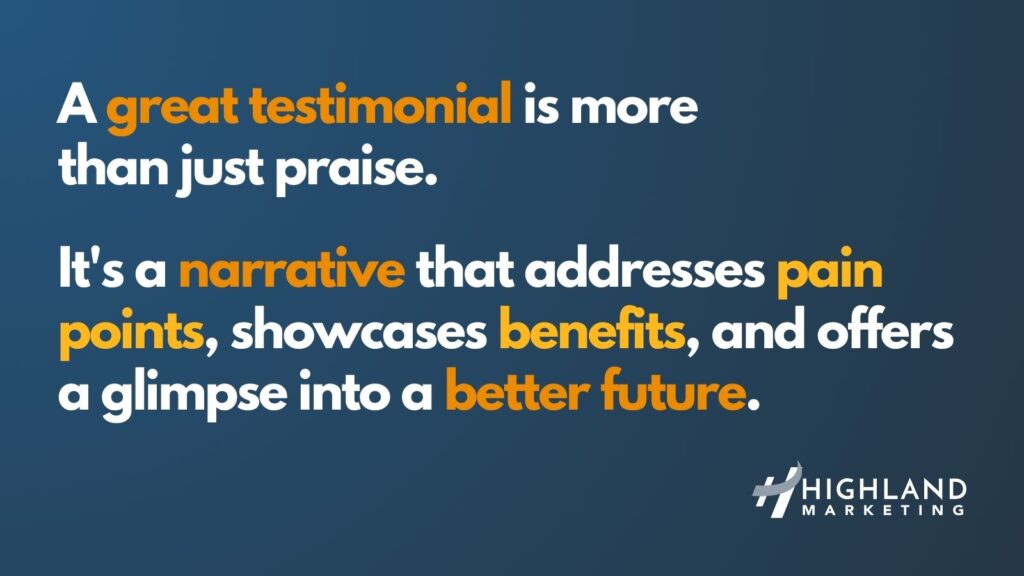In a world where B2B customers cite testimonials and peer recommendations as the most reliable type of content, the power of user testimonials cannot be overlooked.
Especially in the health tech sector, where trust is paramount, testimonials serve as a bridge between scepticism and confidence. This article delves into the art of leveraging these testimonials in health tech marketing, ensuring that your brand not only stands out but also resonates with its target audience.
The power of authentic stories
In the realm of health tech, the stories of real users can be the most compelling marketing tool. When potential customers hear about the tangible benefits others have experienced, it creates a ripple effect of trust. Telling authentic stories is not just about showcasing your product’s features, but about highlighting its impact on real lives.
Why stories matter
Stories have been a part of human culture for millennia. They help us connect, understand, and remember. In health tech marketing, stories provide context. They show potential users not just what a product does, but how it can fit into and improve their lives.
Crafting the perfect testimonial
A great testimonial is more than just praise. It’s a narrative that addresses pain points, showcases benefits, and offers a glimpse into a better future. To craft the perfect testimonial:
- Choose the right users: Not all users will have stories that resonate with your target audience. Identify those who have experienced significant benefits from your product.
- Guide, don’t script: While it’s essential to guide users in giving their testimonials, avoid scripting them. Authenticity is key.
- Highlight specific benefits: General praise is good, but specifics are better. Did your health tech product save time? Improve outcomes? Reduce costs? Highlight these points.
The role of branding in testimonial efficacy
Your brand is more than just a logo or a tagline. It’s a promise, an identity, and a story in itself. When user testimonials are aligned with strong brand building, they become even more potent.
Consistency is key
Ensure that the language, tone, and style of your testimonials align with your brand’s voice. This consistency reinforces brand recognition and trust.
Visual elements matter
Incorporate brand colours, logos, and other visual elements into your testimonials. This not only makes them more engaging but also reinforces brand identity.
Understanding the market landscape
To leverage testimonials effectively, it’s crucial to understand the health tech market landscape. Knowing where your product fits in, who your competitors are, and what your unique selling points (USPs) are can help you position your testimonials strategically.
Identifying your niche
Every health tech product has a niche. Whether it’s a specific medical field, a particular demographic, or a unique problem it solves, knowing this niche can help you tailor your testimonials to resonate with the right audience.
Analysing competitor testimonials
Look at what your competitors are doing. What are their customers saying? How are they presenting their testimonials? This analysis can offer insights into what’s working and where there might be gaps that your brand can fill.
Integrating testimonials into your marketing strategy
Harnessing the power of testimonials requires more than just collecting and showcasing them. It’s about integrating these stories seamlessly into your broader marketing strategy, ensuring they amplify your message and drive engagement.
The multi-channel approach
In today’s digital age, consumers interact with brands across various platforms. From your website to social media, every touchpoint is an opportunity to showcase a testimonial.
- Website integration: Your website is often the first point of contact for potential customers. Dedicate a section to testimonials, ensuring they’re prominently displayed. Use engaging formats like videos or interactive stories to make them stand out.
- Social media spotlight: Share testimonials on platforms like LinkedIn, Twitter, and Facebook. These platforms allow for easy sharing, amplifying the reach of your testimonials.
- Email campaigns: Incorporate testimonials into your email marketing campaigns. They can serve as social proof, increasing the likelihood of conversions.
Leveraging user-generated content
Encourage satisfied customers to share their experiences on platforms like Instagram or Twitter. User-generated content acts as organic testimonials, often reaching audiences you might not have tapped into.
Collaborative content creation
Work with users to co-create content. This could be in the form of blog posts, case studies, or even webinars. Such collaborations not only serve as extended testimonials but also position your users as thought leaders, adding another layer of credibility.
Avoiding common pitfalls
While testimonials are powerful, they can backfire if not used correctly. Here are some pitfalls to avoid:
- Over-editing: While it’s essential to ensure testimonials align with your brand voice, over-editing can strip them of their authenticity. Maintain the original voice and sentiment of the user.
- Using generic praise: “This product is great!” is good to hear, but it doesn’t tell potential customers much. Focus on testimonials that highlight specific benefits and outcomes.
- Ignoring negative feedback: Not all feedback will be positive. Instead of ignoring or hiding negative testimonials, address them. This shows potential customers that you value feedback and are committed to continuous improvement.
Measuring the impact of testimonials
Like all marketing efforts, it’s crucial to measure the impact of your testimonials. This not only helps justify the investment but also offers insights into areas of improvement.
- Engagement metrics: Track metrics like click-through rates, shares, and time spent on testimonial pages. These offer insights into how engaging your testimonials are.
- Conversion rates: Monitor how many leads or sales can be attributed to testimonials. This gives a direct measure of their effectiveness.
- Feedback and surveys: Regularly solicit feedback from your audience. This can offer qualitative insights into how your testimonials are perceived and areas where they can be improved.

The future of testimonials in health tech marketing
As the health tech landscape evolves, so do the ways we communicate and market. Testimonials, while timeless in their appeal, are also undergoing transformations in how they’re sourced, presented, and integrated.
Embracing technology in sourcing testimonials
With the rise of AI and machine learning, there’s potential to tap into these technologies to source and curate testimonials. For instance, sentiment analysis can help brands identify particularly positive user experiences from large datasets, pinpointing potential testimonial candidates.
Virtual Reality (VR) and Augmented Reality (AR) in testimonial presentation
Imagine a potential customer donning a VR headset and immersing themselves in a testimonial. They’re not just hearing a story; they’re experiencing it. As VR and AR technologies become more mainstream, they offer innovative ways to present testimonials, making them more engaging and memorable.
The importance of data protection
With increasing concerns about data privacy and protection, especially in the health sector, it’s crucial to ensure that testimonials are sourced and used ethically. Always seek explicit consent from users before showcasing their stories and ensure any personal data is handled with the utmost care.
Actionable steps for health tech brands
- Stay updated: The health tech market is dynamic. Regularly update your understanding of the landscape, ensuring your testimonial strategies remain relevant.
- Invest in training: Equip your team with the skills to source, curate, and present testimonials effectively. This might involve training in storytelling, video editing, or even VR content creation.
- Engage with your user community: Foster a sense of community among your users. Regularly engage with them, not just to source testimonials but to understand their evolving needs and feedback.
The ROI of effective testimonial marketing
Testimonials, when leveraged effectively, offer a significant return on investment. They not only drive brand awareness and trust but can directly influence purchasing decisions. In the health tech sector, where the stakes are high and trust is paramount, testimonials can be the difference between a product’s success and obscurity.
If you’re looking to harness the power of testimonials in your health tech marketing, consider partnering with experts who understand the nuances of the sector. Highland Marketing offers tailored solutions, ensuring your testimonial strategies are not only effective but also aligned with the latest trends and best practices. Reach out to us today and discover how you can maximise the ROI of your testimonial marketing efforts.


